| enter keyword to search: |
|
Images db
|
|
|
Articles db
|
|
|
|
|
|
|
|
|
The holiest of all Indian pilgrimage sites Varanasi-Benares is located on a high ground along the left shore of the Gange, that here slightly bends toward north, betwenn the confluence of the Vàrunà, a small river, to north and that of another little river almost always dry, the Asi, to south, from which the city takes its name: Varanasi (Benares). Maybe the oldest continually inhabited city, one of the most sacred cities in the world it seems that Varanasi has been a place object of veneration since the most ancient times when the Indo-European tribes it started to populate the Gange valley, certainly at least from the viii c B.C.
A crumbling maze that rises from the ghats on the western banks of the Ganges Varanasi is a magical city in which the most intimate rituals of life and dead are carried out on the famous ghats. Surrounded by an incredible mess of cars, people, motor bikes, Auto Rickshaw (tuc-tuc) and Rickshaw the old city is a cramped labyrinth crowded by pilgrims purchasing flowers and fruits for puja, offered to Shiva in the form of lingam and sacred cows rooting in the rubbish. At afternoon time, milkmen transport milk for delivery, going from one house to another, one shop to another. Used for cooking and in most of the rituals cow dung, gobar, is seen all around.
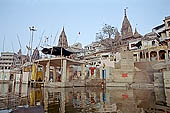
|
Ghats of Varanasi
|
The Ghats
The 90 ghats along the Ganges with the backdrop of xviii and xix c. temples and palaces. Pilgrims in supplication, priests meditate by the rising sun, wrestlers limber up. At dawn devotees come to bathe, and perform ancient rituals to greet the sun, hawan, which means sacrifice to Fire. Women offer Ganga Jal (holy water) with her palms, to the river, to the sun, to the life.
Dashaswamedh Ghat |
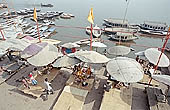
|
Dashaswamedh Ghat
Situated roughly halfway of the waterfront always crawling with pilgrims and priests surveying the scene from under bamboo umbrellas. Dasaswamedha is one of the five tirthas on the Panchatirthi Yatra. Dasashwamedh means ‘das’ ten ‘ashwamedh’ horse, from the ‘mahatmiya’ legend that says in this place Brahmâ performed a sacrifice of ten horses. The Ganga Fire Arti at sunset, pundits (priests) perform arti, age-old ritual prayer with complicated fire rituals, with conch shells and burning braziers accompanied by drummers, while pilgrims light candles to float along the sacred waters.
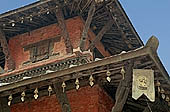
|
Nepali Temple
|
Heading North
Man Mandir Ghat with the beautiful palace converted into an observatory in 1710.
Lalita Ghat named after Lalita goddess (the one who plays) with the Nepali Temple, a typical Newari-style beautiful wooden carved temple. The lingam here replicates the famous Pasupatisvara at Pashupatinath (Shiva manifestation as lord of all creatures) in the Kathmandu Valley.
Manikarnika Ghat the great cremation ground (Mahasmasana) is one of the most interesting ghat of Benares. Strictly speaking, Manikarnika is the name given to the kund and to the ghat, while the constantly busy cremation ground is called Jalasi Ghat, dominated by a dark smoke-stained temple built in the eighteenth century. The ghat is perpetually crowded with funeral parties, lying on a stretcher, made of two bamboo poles and seven pieces of bamboo tied in between,. corpes are wrapped in a sheet, white for man and red for women, the procession is leaded by the eldest son funerals are continuously performed, tended by the doms, an untouchable caste, . All around poles are erected to the memories of the widows that committed Sati (the suicide on the pire of their husband).
Manikarnika Kund, (Cakra-Puskarini Kunda the Discus Lotus-Pool) the sacred well of said to have been dug by Vishnu with his chakra at the time of creation. Pilgrims worship at its small Vishnu shrine, and at the Carana Paduka, footprint of Vishnu, close the embankment of the ghat along with the remains of Tarakeshvara lingam, Shiva as Lord of Taraka mantra, a "prayer of the crossing" recited at death.
Scindia Ghat, with its distinctive half-submerged Shiva temple.
Panchganga Ghat the five (panch) mythical rivers (ganga): Kirana (Sun’s Ray), Yamuna, Saraswati and Dhuta-papa (Cleansed of Sin) that flow here into the Ganges, it is one of the five tirthas.
Behind, the ghat is dominated by the great Alamgir mosque, with its minarets is a mix of Hindu and Mughal styles. It was built by Aurangzeb on the site of Bindu Madhava a huge Vishnu temple, that extended from Panchganga to Rama Ghat before it was destroyed and replaced by this impressive mosque.
Along the bank, almost submerged, there are cells some with lingams, others with images of Vishnu, and some empty and used for meditation or yoga by the pundits (priests).
Gai, Trilochana, and Raj (Raja) ghats. with the red tower, and Causathi Ghat the last one at the North.
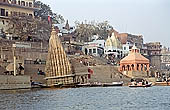
|
Scindia Ghat
|
Heading South
The impressive stone steps of Chaumsathi Ghat. Overlooking the ghats here is Peshwa Amrit Rao’s majestic sandstone haveli (mansion), (xix c.).
Dhobi Ghat, alive with the sound of dhobi, (laundrymen) rhythmically beating at morning time clothing on the stones.
Kedara Ghat notable for its red-and-white-striped South Indian–style temple of Kedaresvara lingam.
Harishchandra Ghat, Varanasi second cremation ghat named after King Harish Chandra.
Tulsi Ghat originally Lolarka Ghat and now remaned in honour of the Hindu poet Goswami Tulsidas, that translated in hindi the Ramayana, written in Sanskritic language.
Assi Ghat the southernmost ghat situated at the confluence of the Ganga and Assi rivers. The Asi-Ganga sangamam (Asi-sangameshwara) the lord of the confluence of Asi river.
Lolark Kund the Trembling Sun, here childless women come to bathe and pray for progeny, it is a temple to the Sun God. ancient Vedic God Sun-Ravi, or Surya. This is among Varanasi erliest site one of the only two remaining Sun sites linked with the origin of the Hinduism. The sun is known as well as Savita, Gayatri, Dinkaar (the one who makes the day) the greatly effulgent sun of Kasayapa the enemy of darkness, and destroyer of all sins. Appearing in twelve forms adytas (in the shape of twelve months of the year) He is the lord of the stars, planets and constellations the subtle body of time - Kaal purush : Sun is his soul, Moon its sense and emotion, Mars its strength and so on.
Dhobi Ghat |
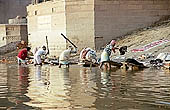
|
The Old City
Vishwanatha Khanda, sometimes referred to as the Old City is the heart of Varanasi, between Dashashwamedha Ghat and Manikarnika Ghat, with numerous shrines and lingams tucked into every corner, and buzzing with the activity of pilgrims and stalls selling offerings to the faithful. This is the site of the Antargrha-yatra the innermost circumambulatory route that encircles the centre before it reaches the centre, Visvesvara.
Approached through a maze of narrow alleys, the temple complex of Vishwanatha (Visheshwara Visweswara Viswanatha), the ‘Lord of All’, is popularly known as the Golden Temple, due to the massive gold plating of its shikhara and dome. Of the more than 2,000 temples in Varanasi, the Visheshwara is the most important. Dedicated to Shiva the temple enshrines one of the twelve Jyotirlingams, the lingam of light, as well as the shrines to the wrathful protectors Mahakala, Dandapani and the lingam of Avimukteshvara, the Lord of the Unforsaken, which predates the cult of Vishwanatha.
The temple has been repeatedly sacked by Muslims but every time it has been reconstructed, until 1669 when Aurangzeb finally destroyed the grand edifice of 1585 and built on its ruins a great mosque the Jnana Vapi Mosque, so that it would not be reconstructed anymore. What we see today it is a later reconstruction dated 1777 made close by the original site. Today the temple area that comprises also the the Great Mosque of Aurangzeb is guarded by armed police to prevent fanatisms. The mosque is a simple white domed edifice. In the area under an open arcaded hall there is also the Well of Knowledge (Jnana Vapi). The waters of this well become particularly sacred when, at the time of the Aurangzeb destruction, an inspired brahmin thrown in it the statue of the god, so that it could not be contaminated from the Moslems. Today it is believed that the waters of the well confers the Divine Knowledge and those people that drink it attain the moksha, the final emancipation from the cycle of births.
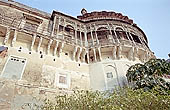
|
Ramnagar Fort
|
Ramnagar Fort the palace of the former Maharaja of Varanasi (about 1740), surrounded by a fort is the only site on the east bank of the river. It is a rather decaying building now a museum filled with dusty, moth-eaten exhibits, such as the once ornate howdas (elephant seats) that transported the royal family.
Bharat Mata Temple - Mother India Temple. During India's struggle for freedom people perceived their land as Bharat-Mata now India's most widely worshipped deity. Instead of the customary images of divinity pilgrims walk around a large relief map of the subcontinent before Partition, featuring all its holy tirthas, mountains, and rivers. It seems that the map is perfectly in scale, is in horizontal is in vertical. The temple was inaugurated by the Mahatma Gandhi.
Durga temple Shri Siddha Peeth Durga Devi Temple, famous with the name of Monkey Temple this temple (xviii c.) is an example of nagara style of northern India, with one sikhara in red ochre the colour of Durga. Goats are conducted here to be beheaded and their blood offered Durgà in memory of its disposition to destroy the demons. Durgà, "the inaccessible one" it is always a victorious divinity, invoked in the fights. Its temple is out of the sacred perimeter devoted to Shiva, since any animal or living being can be killed in the holy city.
Tulsi Manas temple
built on 1964 with white marble walls this temple is dedicated to Lord Rama. The temple is in the place where Goswami Tulsidas composed the epic 'Ramacharitramanas' the Hindi Ramayana.
Sankat Mochan temple
at a walking distance from Durga temple, it is dedicated to Lord Hanuman the 'Liberator from Troubles'. According to Vedic Astrology, Hanuman protects human beings from the anger of planet Saturn and those who have ill placed Saturn in their horoscope visit the Sankat Mochan temple to get remedy. People put 'Sindoor' on the statue and offer 'laddoos' to Lord Hanuman.
New Vishwanath temple
within Banaras Hindu University. Dedicated to Shiva this temple with its white marble sikkara should be a copy of the ancient Vishwanath Temple. The interior has a Siva lingam and verses from Hindu scriptures inscribed on the walls.
Ancient Celestial Observatory
Above the Man Mandir Ghat the mahàràjah of Jaipur, Jai Singh II, built one of his five observatories, which however, currently is found under miserable conditions, and it possesses only few tools without great interest.
Durga temple |
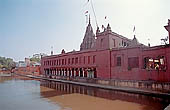
|
| |
|
|
 |
|
|



